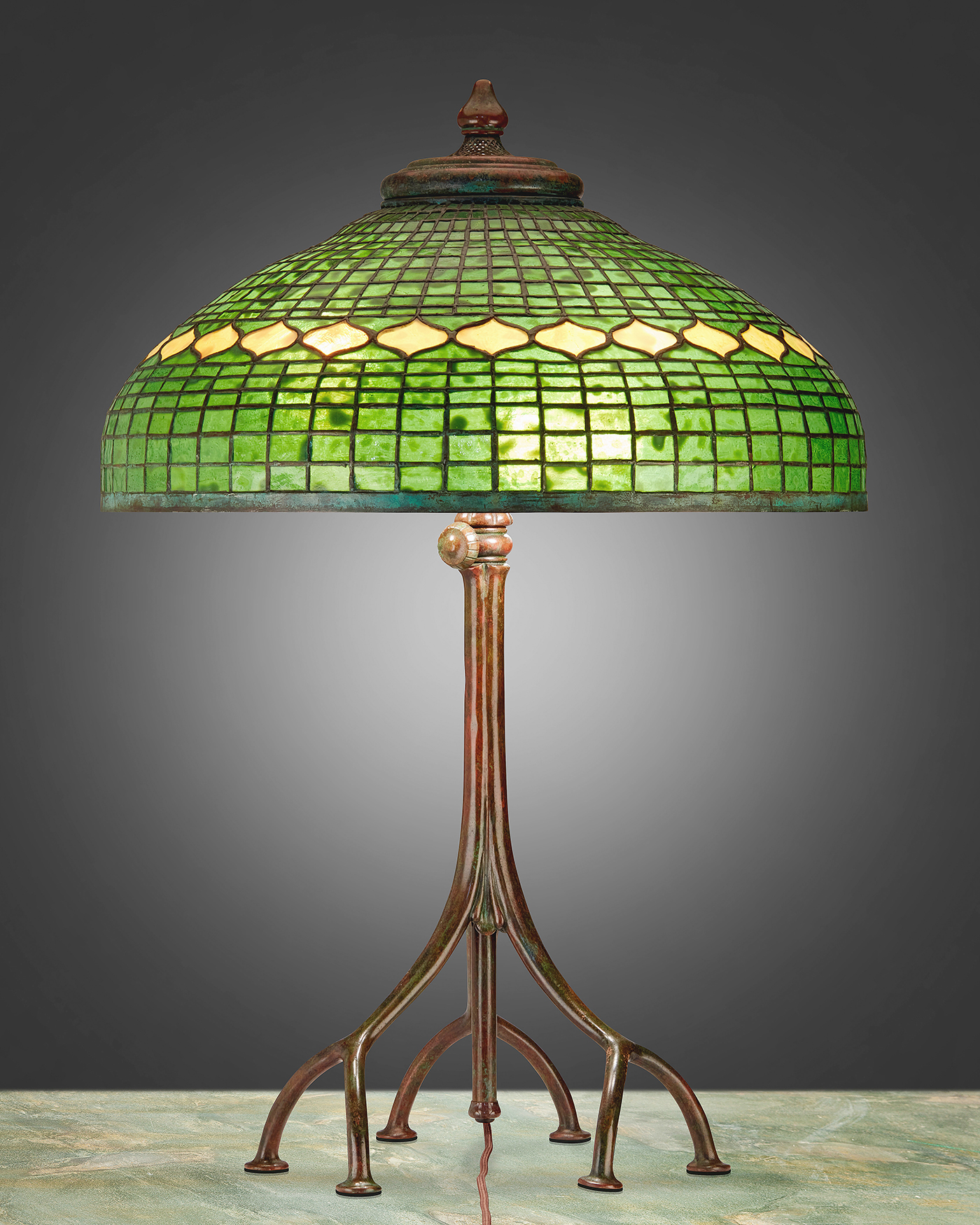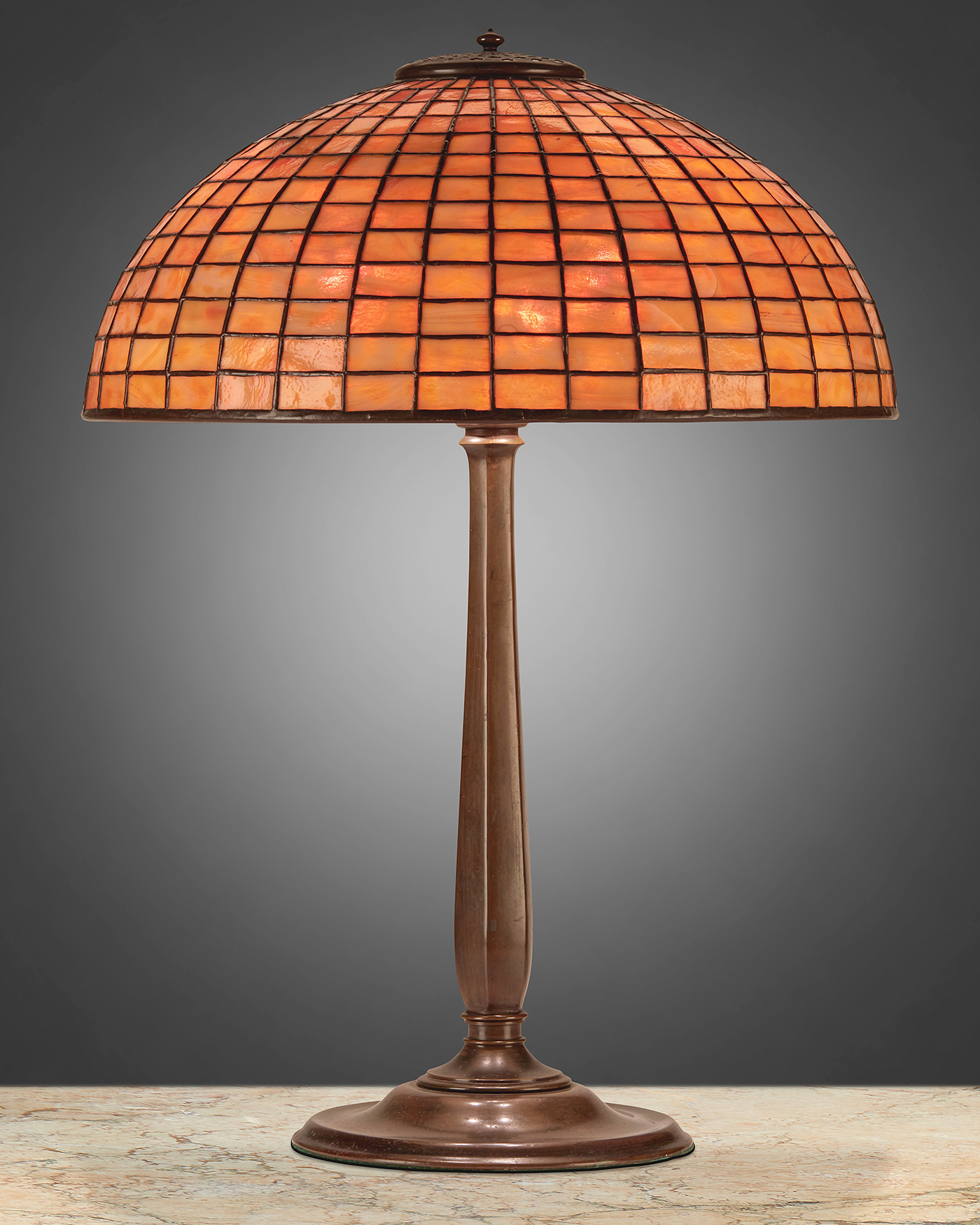
A Tiffany Studios “Arrowroot” table lamp was the top lot, realizing $42,250. “A pretty iconic form,” said head of sale Maranda Moran, “with an Arts and Crafts aesthetic as well as some Art Nouveau. The glass in it was lovely. It’s a form that was made in a variety of different colors, and this one was just right on with the green shoots and background color.”
Review by W.A. Demers, Photos Courtesy John Moran Auctioneers
MONROVIA, CALIF. – A Tiffany Studios Arrowroot table lamp sold for $42,250 on March 2, the top lot at John Moran Auctioneers’ single-owner sale from the Alan Schneider collection. More than 91 lots of Tiffany Studios objects and lighting graced the 288-lot sale, which included glass, furnishings, candlesticks and reverse-painted lamps from Handel and Pairpoint. Totaling $1.1 million and achieving 175 percent of estimated value, it was a “white glove” event, 100 percent sold.
More than 1,000 registered bidders lined up on three online platforms – Moran’s own, Invaluable and LiveAuctioneers – or worked on the phones with ten agents to get a piece of the Schneider collection of American and European art glass and furnishings from the late Nineteenth and Twentieth Centuries. Featured names like Tiffany Studios, Handel, Pairpoint, Daum Nancy, Majorelle and Galle, among other notable makers, were pursued, though the day clearly belonged to Tiffany Studios in terms of top sellers, its lighting comprising the bulk of the sale’s top 20 lots.
Schneider owned and operated a small shop, Antique Traders, in the heart of San Francisco. A man with a keen eye for the rare and beautiful, for more than 50 years he searched for the best in American cut glass, Arts and Crafts lighting and everything in between. His knowledge was expansive and his passion for historic museum-quality pieces made his business one of the go-to destinations for turn-of-the-century lighting in the United States.

A Tiffany Studios Favrile glass and bronze chandelier was bid to $31,250. Said Moran, “It has a pretty unusual form. It’s not your traditional stained glass fixture, and it has a kind of a nice appeal in that it has a broad use because of its rectangular format. It could go over a wide variety of furniture — you could put it over your pool table or in your dining room. It could be an entryway piece. It has a kind of a good aesthetic and nice proportion. The shades are all original and signed. The patina, the chain, everything was just right on.”
Maranda Moran, furniture and decorative arts specialist and head of sale, told Antiques and The Arts Weekly that Schneider’s daughter afforded Moran’s the honor of selecting pieces for this auction. “She liked the idea of honoring her father as a true enthusiast in a single-owner sale,” said Moran. The firm’s specialists spent an entire week hand-picking illuminating selections from his shop and private collection. “Alan Schneider was a collector-turned-dealer,” said Moran. “He was known as not having the most friendly relationship with prices. Nothing that we picked up had a price tag on it. I had the feeling that it was his office. He’d go to the store every day, and maybe he’d sell a couple of super-high-end lamps a year, and for the rest he enjoyed the company of the objects.” Moran related that when her team arrived to inventory the collection, “it literally took six people three days to find one flat surface on which to put a laptop. It was like the best hoarder situation ever.”
Included in the single-owner sale was unique lighting exhibiting the range of decorative styles of the Twentieth Century, including Arts and Crafts, Art Nouveau and Italian midcentury. Cameo, cut and favrile glassware, both table and hanging lamps from Tiffany Studios were on offer, as was furniture from Galle and Majorelle accompanied by silver and glass objects from around the globe.
As to why the sale’s top echelon was so heavy with Tiffany lighting, Moran opined, “I have a couple of thoughts. Alan had a keen eye, and he bought what he loved. He had some really choice examples over a wide gamut of price points, so what we offered was very approachable. It’s a very specific client who buys a million-dollar ‘Wisteria,’ but a ‘Vine Border’ with an elegant base, it’s approachable in its size and price point.”

The top Tiffany Studios “Vine Border” table lamp earned $29,250. “This had the gold geometric wide bands of foliage,” said Moran, the shade pairing very nicely with the base. “A really nice package.”
The other reason, she suggested, is the nature of the world we’ve all been living in over the past year. “It’s Covid. And people are sitting in their new home offices doing Zoom meetings and they’re thinking ‘My space needs to be improved.’ I’m sure that a lot of these will be going into those home offices.”
The top selling Tiffany lamp featured a polychromed leaded glass Arrowroot shade on a three-light gilt-bronze “Fifteenth Century” base with straight column and incised square patterning.
A total of 18 bids took a Tiffany Studios Favrile glass and bronze chandelier from its $15/20,000 estimate to a final price of $31,250. Circa 1902-19, the square-form, eight-light, verdigris patinated bronze chandelier with gold iridescent Favrile glass floriform shades featured turned-style corner mounts, a drop finial, and suspended chain link harness. Measuring 55 by 28 by 28 inches, its seven shades were signed L.C.T, and one shade bore the signature L.C.T. Favrile. The bronze fixture appeared to be unsigned.
Two Tiffany Studios “Vine Border” table lamps each realized $29,250. The first, circa 1902-19, balanced its green and blue leaded glass “Vine Border” shade on a three-light patinated bronze narrow urn-form “Greek” base and measured 21½ by 18 inches in diameter. The shade was signed: Tiffany Studios / New York / 1470, and the base was signed Tiffany Studios / New York / 441. It had been illustrated in Alastair Duncan’s Tiffany Lamps and Metalware, 2007, page 144, fig. 603.
The other “Vine Border” example, also circa 1902-19; sat on a six-light patinated bronze Tiffany-style reproduction base in the form of three spreading root nodes. Overall 29 inches high by 20½ inches diameter, its shade was signed Tiffany Studios / New York, while the base was spuriously signed Tiffany Studios / New York / 393.

This Tiffany Studios “Vine Border” table lamp with the root base, according to Moran, was a bit of a mystery. “While we couldn’t really attribute the base to Tiffany and indicated that it was ‘spurious,’ whoever bought it didn’t have any problem with the base.” It sold for $29,250.
Fetching $28,125 against its $15/20,000 estimate was a Tiffany Studios “Turtle-Back” table lamp. Overall, 24 inches high by 20 inches diameter, the green leaded glass “Turtle-Back” shade of the circa 1902-1919 lamp rested upon on a three-light patinated bronze base with an ovoid body supported by three arms and decorated with a “Turtle-Back” glass band. The shade was signed: Tiffany Studios / New York / 1484-9, and the base was unsigned.
The same amount would have won a Tiffany Studios ten-light “Pond-Lily” table lamp, a confection of gold-finished bronze, circa 1902-1919, its “Pond Lily” base designed with lily pads issuing a drop cluster of ten gold iridescent Favrile glass “Blossom” shades. Each shade was signed L.C.T. and the base was signed Tiffany Studios / New York / 381.
Bidders liked a Tiffany Studios “Pomegranate” table lamp, pushing it from its $6/8,000 estimate to finish at $26,000. Here, the design featured a yellow and green leaded glass “Pomegranate” shade on a three-light patinated bronze four-legged “inverted cradle” base. The circa 1902-19 lamp’s shade was signed Tiffany Studios / New York / 1457, and the base was signed Tiffany Studios / New York. It measured 23½ inches high with a 16-inch diameter.
An engineer’s favorite, a Tiffany Studios counter-balance floor lamp, realized $24,700, three times its high estimate. The lamp’s blue iridescent “Wave” Favrile glass shade featured tones of pink, yellow and green and sat upon on a single-light patinated bronze counter-balance base with plain narrow stem, weighted ball in a foliate cradle and adjustable head raised on five curved legs with spade feet. Overall, it stood 54 inches high and its shade had a 10¼-inch diameter. There were others of this design. One with a yellow iridescent “Wave” Favrile glass shade, going out at $13,750, and another with a green iridescent favrile-style art glass shade that earned $13,000.
Favrile distinguishes itself from other iridescent glasses because its color is part of the glass rather than just applied to the surface. The making of Favrile was likely a collaboration between Louis Comfort Tiffany and the company’s first glass blower, Thomas Manderson. Tiffany patented the innovative technique in 1894.
A fine hanging example was a “Curtain Border” lamp, which was bid to $23,400. Signed Tiffany Studios / New York / 1515-39, it featured a yellow leaded glass domical shade with green diamond band and curtain-style border fitted with a six-light socket cluster, patinated bronze heat cap and suspended chain link harness, and verdigris patinated bronze rims. Electrified, it measured 13 inches high by 24 inches diameter.
A couple of other notable designs featured among the top sellers was a Tiffany Studios double student lamp, circa 1900. Offered originally with both leaded and damascene shades, such a lamp captures the pinnacle of the pine needle series of desk items. A strong staple of the Art Nouveau movement, this scholarly piece sits regally atop its bronze base, according to catalog notes. It finished at $11,250.
The Handel Company was well known for its reverse-painted table lamps, and the sale offered an example of that craftsmanship. The lamp’s hand painted pine needle and parrot motif was further distinguished by an uncommon lavender background, and it realized $15,000.
Prices given include the buyer’s premium as stated by the auction house. Moran’s next sale, California Living, on April 13 will offer a further 125 lots from the Schneider collection.
For additional information, 626-793-1833 or www.johnmoran.com.

























